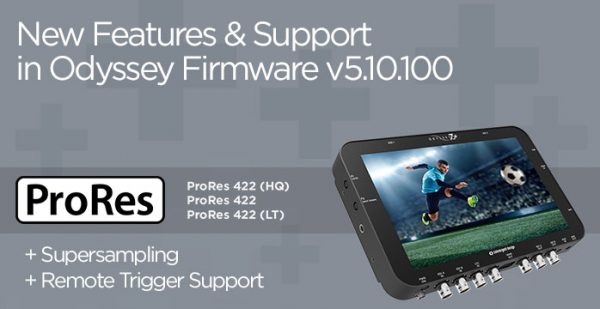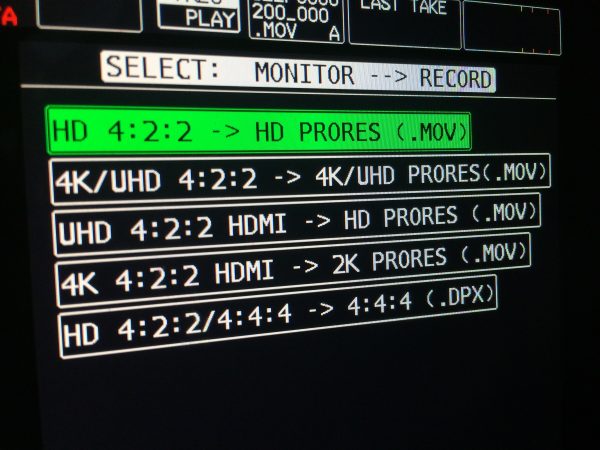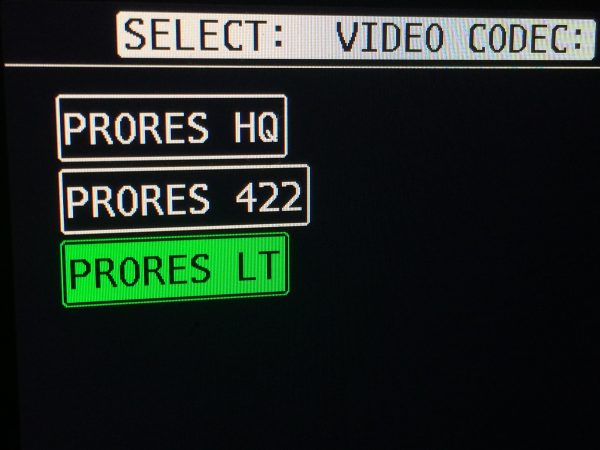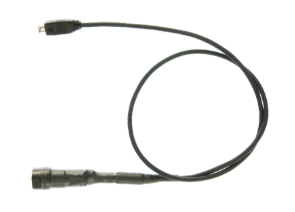By technical editor Matt Allard:
Convergent Design have released yet another firmware update for the Odyssey 7, 7Q and 7Q+. The new firmware includes such features as 4K (4096×2160) HDMI to 2K Downscale for the Panasonic GH4 and Sony FS7 (7Q+ Only) at 23.98,24,25,29.97p, and UHD (3840×2160) HDMI to HD Downscale for Sony A7s,FS7 and Panasonic GH4 (7Q+ only) 23.98,24,25,29.97p. Convergent Design have also now included the ability to change the flavour of Apple ProRes recorded between ProRes LT (140Mb/s), ProRes (100Mb/s) and ProRes HQ.
Two of the stand out features of the Odyssey 7Q and 7Q+ have been the ability to record 4K ProRes from the 4K RAW output of several cameras, or alternatively a down converted HD image from a 4K RAW output. The latter is useful as the final HD results of downsampling in the recorder can best what the cameras do themselves internally.
If you own a FS7 with the XDCA-FS7 pack there are now new options to get Apple ProRes LT and ProRes support for 4K RAW to 4K ProRes (24,25,30p), 4K RAW to UHD ProRes (24,25,30p), 4K RAW to 2K ProRes (24,25,30,50,60p) and 4K RAW to HD ProRes (24,25,30,50,60p).
Sony FS700R users get Apple ProRes LT and ProRes support for 4K RAW to 4K ProRes (24,25,30p), 4K RAW to UHD ProRes (24,25,30p), 4K RAW to 2K ProRes (24,25,30,50,60p), FS700 Burst Support in HD/ 2K ProRes and 4K RAW to HD ProRes (24,25,30,50,60p). Additionally there is FS700 Burst Support in HD/ 2K ProRes4K Raw to 2K ProRes 100/120p burst and 4K Raw to HD ProRes 100/120p burst.
The full list of new features can be found at the bottom of the article.
The 4K HDMI to 2K Downscale and UHD HDMI to HD Downscale options are the most exciting news. I have previously used the 4K RAW to HD down convert on my Sony FS700 with a lot of success. This gave me the best possible HD image from the FS700 while keeping the amount of data I was recording down. I have also been using UHD recording from the a7S to the 7Q+ which is great but the amount of data you end up with is quite immense. The choice to be able to record that UHD HDMI to HD Downscaled image in different flavours of ProRes is something I have very much been looking forward to – like the FS700 the quality of the HD image created this way is in many ways better than the straight HD image from the a7S. The UHD HDMI to HD Downscale when recording in ProRes LT gives you 6 hours and 4 minutes of record time on a 256GB SSD. If you record straight UHD in ProRes HQ you only get 39 minutes. Clearly if you only require HD and LT then the new option is going to save a lot of space.
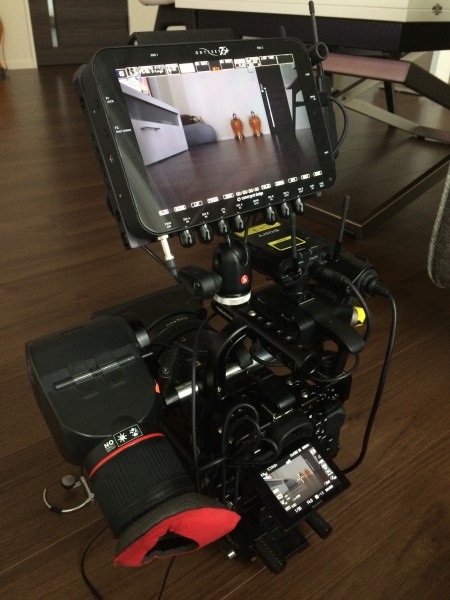
I was very keen to test out the new UHD HDMI to HD Downscale on my Sony a7S and the soon to be released JVC GY-LS300. Having the option to take the UHD output of those cameras but still record in ProRes HD gives you a lot of flexibility. I wanted to see if the quality of the image being recorded from the UHD HDMI to HD downscale was as good as taking the UHD image and putting it on a HD timeline (letting the editing software do the downconversion).
Of course there are instances where UHD HDMI to HD Downscale is not going to replace recording straight UHD to the 7Q+. Clearly if you need a 4K finish then you have to record 4K. Also, if you are planning on doing re-framing in post then using a UHD image on a HD timeline is still the way to go. If however you are just looking for a great image that you want to use on a HD timeline then this new option really does save you some serious data headaches.
Below is a test I did using the Sony a7S and JVC-GY-LS300 comparing the UHD HDMI to HD Downscale to recording the straight HD signal coming out of the cameras. These are in no way scientific tests, but to my eye the image you get using the UHD HDMI to HD Downscale is a lot more detailed and sharper than recording straight HD either internally or externally. You can especially notice the difference when recording XAVC-S internally on the a7S as compared to externally. The trade off with recording the UHD signal from the a7S seems to be a noiser image, but it can be worth it to get the added sharpness and resolution. The XAVC-S internal recording is not nearly as sharp but as far as noise goes it has a lot less. The JVC-GY-LS300 with it’s 35mm sensor really surprised me. The image coming out of that camera when recording the UHD HDMI to HD Downscale was very sharp and detailed even when cropping in 300%. To my eye it has a sharper, more detailed UHD image than the a7S. The same Zeiss ZF2 100mm f2 macro was used on both cameras for the test.
You can download the files here:
7Q+ UHD to HD Downloads JVC GY-LS300.mov
7Q+ UHD to HD Downloads Sony a7S.mov
There are still a few things that I would of like to see included on the 7Q and 7Q+. On my list would be Apple ProRes 4444 recording and the ability to load up your own customisable LUTs, but I have been told they are coming. One other strange thing is that the multi stream recording which was one of the big features mentioned when the original 7Q was announced is still not available.
This from Convergent Design:
Mitch Gross CD White Paper description
HDMI 4K->2K / UHD->HD Supersampling
An HDMI-based 4K (4096×2160) or UHD (3840×2160) video signal can be supersampled in realtime in the Odyssey7Q+ to a 2K (2048×1080) or HD (1920×1080) video signal and recorded in Apple ProRes (HQ, 422, or LT).
Some cameras that, over HDMI, can output 4K or UHD can also output 2K or HD. But many of the smaller cameras are limited in the quality of their lower resolution outputs. Some truncate the bit depth to 8-bit, and some lower the resolving capabilities due to either limited circuitry space within the camera or to protect the internal recording codecs that cannot handle highly detailed imagery.
The Odyssey7Q+ devotes considerable computational power to supersampling the 4K or UHD video signal to yield superior resolution 2K or HD results in realtime, without aliasing or “false resolution.” The resulting images out-resolve the in-camera processing available in many small cameras. Another advantage is if the camera is limited to 8-bit output, the Odyssey7Q+ supersampling will result in a pseudo-10-bit color sampling for improved color reproduction. Use Apple ProRes 422 (HQ) to take full advantage of these improvements. Examples of cameras benefitting from the 4K->2K / UHD->HD Supersampling include the Panasonic GH4 and the Sony a7S.
Additionally, some cameras such as the Samsung NX-1 do not offer a clean 1080p output at all, so the UHD->HD mode is the only way to record an HD signal from the camera.
While any 4K or UHD video can be reduced to 2K or HD in post, this requires four times as much Odyssey SSD recording space, four times the offload time, four times the memory space in drives on set and off, and considerable extra horsepower in the post system. Get the highest quality 2K or HD video out of your camera with the greatest efficiency, courtesy of the Odyssey7Q+.
Here are tests done by Convergent Design that you can download and check out yourself:
The chart used is one developed by Jesse Rosen at AbelCine. In the center target, the wedge on the lower left marked 5 represents 500 line pairs per screen height. 500 line pairs is very close to 1080 lines, so this would be the theoretical limit for a high-resolving 1080p image.
Remote Trigger Support:
The Convergent Design Odyssey Remote Trigger is a pushbutton active remote start/stop trigger for Odyssey monitor/recorders. Remote Trigger feature has been enabled in firmware version 5.10.100 in HD ProRes recording only. The trigger button illuminates while recording. The trigger plugs into the RMT port on the left side of the Odyssey and comes in a six foot standard cable length. Custom cable lengths and breakout cables for triggering multiple Odysseys are available for special order.
Odyssey7 & Odyssey7Q/7Q+ Firmware v5.10.100 Features
NEW FEATURES (ODYSSEY7Q+)
– HDMI 4K/UHD -> 2K/HD Supersample
4096×2160 to 2048×1080 23.98, 24
3840×2160 to 1920×1080 23.98, 24, 25, 29.97
High quality supersampling of 4K/UHD video signal over HDMI yields 2K/HD video superior to that available directly from some small cameras
NEW FEATURES (ODYSSEY7Q & ODYSSEY7Q+)
– Apple ProRes 422 & Apple ProRes 422 (LT) Support
4K/UHD/2K/1080/720 resolutions all supported
4K/UHD up to 30p; 2K/1080/720 up to 60p
– Sony F35 12-bit/10-bit RGB 4:4:4 Support
12-bit or 10-bit RGB 4:4:4 recording in uncompressed DPX stacks
Dual-link capture, 23.98, 25, 29.97
– Sony FS7/FS700 Record Option Adds Apple ProRes 422 & Apple ProRes 422 (LT)
(FS7/FS700 Record Option Required.)
Option of Apple ProRes 422 or Apple ProRes 422 (LT) for
4K RAW -> 4K Apple ProRes 23.98, 25, 29.97
4K RAW -> UHD Apple ProRes 23.98, 25, 29.97
4K RAW -> 2K Apple ProRes 23.98, 25, 29.97, 50, 59.94
4K RAW -> HD Apple ProRes 23.98, 25, 29.97, 50, 59.94
– Sony FS700 Record Option Adds High Speed Burst in 2K/HD Apple ProRes
(FS7/FS700 Record Option Required. Feature only available for FS700.)
Option of Apple ProRes 422 (HQ), Apple 422 or Apple 422 (LT) for
4K RAW Burst -> 2K Apple ProRes 100p, 120p
4K RAW Burst -> HD Apple ProRes 100p, 120p
– Canon C500 Record Option Adds Apple ProRes 422 & Apple ProRes 422 (LT)
(Canon RAW Record Option Required.)
Option of Apple ProRes 422 or Apple ProRes 422 (LT) for
4K RAW -> 4K Apple ProRes 23.98, 24, 25, 29.97, 30
QHD RAW -> UHD Apple ProRes 23.98, 24, 25, 29.97, 30
NEW FEATURES (ODYSSEY7, ODYSSEY7Q & ODYSSEY7Q+)
– Apple ProRes 422 & Apple ProRes 422 (LT) Support
1080p, 1080i & 720p supported
– Odyssey Remote Trigger Supported
New Odyssey Remote Trigger (cable remote with record indicator)
HD Apple ProRes recording only
FIXES & IMPROVEMENTS
– FIXED HDMI video Legalizing issue on some cameras
– FIXED FS7 RAW DNG magenta cast
– FIXED FS7 RAW DNG compatibility with Adobe, FCPX & Scratch Lab
– FIXED C300 1080p30 playback
– FIXED FS7 RAW to Apple ProRes S-Log2
– FIXED C100 & FS100 1080p24 support
– IMPROVED Playback performance
– IMPROVED Safe Eject errors
– IMPROVED FS700 LUTs
THIRD PARTY DEVELOPMENTS
– Nick Shaw of Antler Post worked with Convergent Design to develop Resolve Workflow for FS7/FS700 .DNG files. Also created corrective LUTs for FS7 DNG files created in firmware builds prior to this release (versions 2.1.100 – 4.1.100)
– Prosoft Engineering has updated Picture Rescue 2 to recover ALL file types from Convergent Design SSDs. Even if a Safe Eject was not performed, this inexpensive utility can rescue the files.

